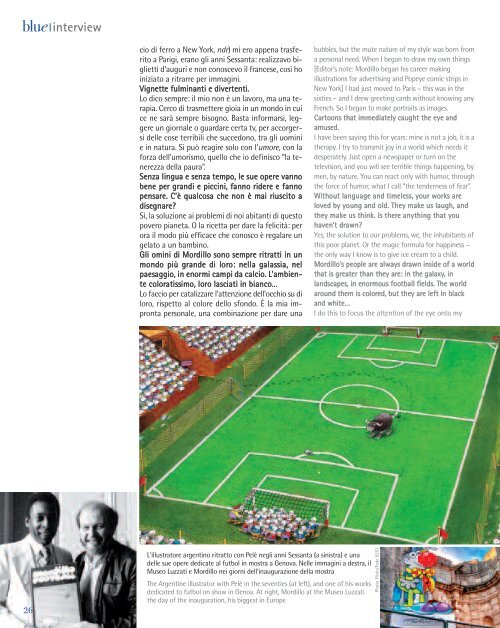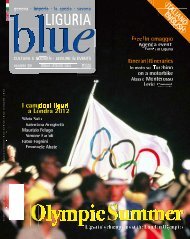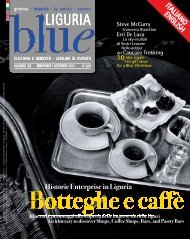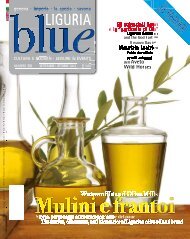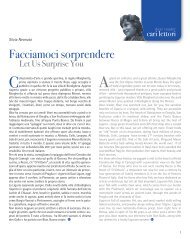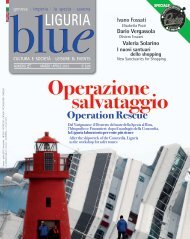You also want an ePaper? Increase the reach of your titles
YUMPU automatically turns print PDFs into web optimized ePapers that Google loves.
lue<br />
26<br />
interview<br />
cio di ferro a New York, ndr) mi ero appena trasferito<br />
a Parigi, erano gli anni Sessanta: realizzavo biglietti<br />
d’auguri e non conoscevo il francese, così ho<br />
iniziato a ritrarre per immagini.<br />
Vignette fulminanti e divertenti.<br />
Lo dico sempre: il mio non è un lavoro, ma una terapia.<br />
Cerco di trasmettere gioia in un mondo in cui<br />
ce ne sarà sempre bisogno. Basta informarsi, leggere<br />
un giornale o guardare certa tv, per accorgersi<br />
delle cose terribili che succedono, tra gli uomini<br />
e in natura. Si può reagire solo con l’umore, con la<br />
forza dell’umorismo, quello che io definisco “la tenerezza<br />
della paura”.<br />
Senza lingua e senza tempo, le sue opere vanno<br />
bene per grandi e piccini, fanno ridere e fanno<br />
pensare. C’è qualcosa che non è mai riuscito a<br />
disegnare?<br />
Sì, la soluzione ai problemi di noi abitanti di questo<br />
povero pianeta. O la ricetta per dare la felicità: per<br />
ora il modo più efficace che conosco è regalare un<br />
gelato a un bambino.<br />
Gli omini di Mordillo sono sempre ritratti in un<br />
mondo più grande di loro: nella galassia, nel<br />
paesaggio, in enormi campi da calcio. L’ambiente<br />
coloratissimo, loro lasciati in bianco…<br />
Lo faccio per catalizzare l’attenzione dell’occhio su di<br />
loro, rispetto al colore dello sfondo. È la mia impronta<br />
personale, una combinazione per dare una<br />
L'illustratore argentino ritratto con Pelè negli anni Sessanta (a sinistra) e una<br />
delle sue opere dedicate al futbol in mostra a Genova. Nelle immagini a destra, il<br />
Museo Luzzati e Mordillo nei giorni dell'inaugurazione della mostra<br />
The Argentine illustrator with Pelè in the seventies (at left), and one of his works<br />
dedicated to futbol on show in Genoa. At right, Mordillo at the Museo Luzzati<br />
the day of the inauguration, his biggest in Europe<br />
bubbles, but the mute nature of my style was born from<br />
a personal need. When I began to draw my own things<br />
[Editor’s note: Mordillo began his career making<br />
illustrations for advertising and Popeye comic strips in<br />
New York] I had just moved to Paris – this was in the<br />
sixties – and I drew greeting cards without knowing any<br />
French. So I began to make portraits as images.<br />
Cartoons that immediately caught the eye and<br />
amused.<br />
I have been saying this for years: mine is not a job, it is a<br />
therapy. I try to transmit joy in a world which needs it<br />
desperately. Just open a newspaper or turn on the<br />
television, and you will see terrible things happening, by<br />
men, by nature. You can react only with humor, through<br />
the force of humor, what I call “the tenderness of fear”.<br />
Without language and timeless, your works are<br />
loved by young and old. They make us laugh, and<br />
they make us think. Is there anything that you<br />
haven’t drawn?<br />
Yes, the solution to our problems, we, the inhabitants of<br />
this poor planet. Or the magic formula for happiness –<br />
the only way I know is to give ice cream to a child.<br />
Mordillo’s people are always drawn inside of a world<br />
that is greater than they are: in the galaxy, in<br />
landscapes, in enormous football fields. The world<br />
around them is colored, but they are left in black<br />
and white…<br />
I do this to focus the attention of the eye onto my<br />
Photo Flickr/Fede 0253


